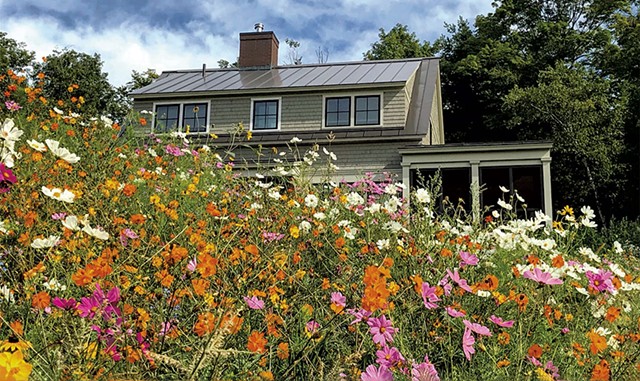
- Courtesy Of Charlotte Addison
- Wildflowers at Charlotte Addison's home in Charlotte
At the end of a long industrial drive in Fairfax is a warehouse piled floor to ceiling with seeds. Workers weave between aisles of neatly stacked bins with labels such as "Partial Shade" or "Northeast Mixture." Ultimately, the seeds will be packed up in little muslin sacks and shipped off to all corners of the country. It's almost planting season, and American Meadows' wildflower business is booming.
The Vermont e-retailer, with headquarters in Shelburne in addition to the Fairfax warehouse, has been selling seeds for 25 years. It specializes in wildflower mixes, including preplanned garden kits — that is, professionally chosen collections of flower varieties that come with a map showing where to plant them. American Meadows moved trillions of seeds last year and is planning for more growth this year.
While wildflowers are beautiful to look at, American Meadows hopes these seeds will sow a greater purpose: The company aims to rewild 1 million lawns across the United States.
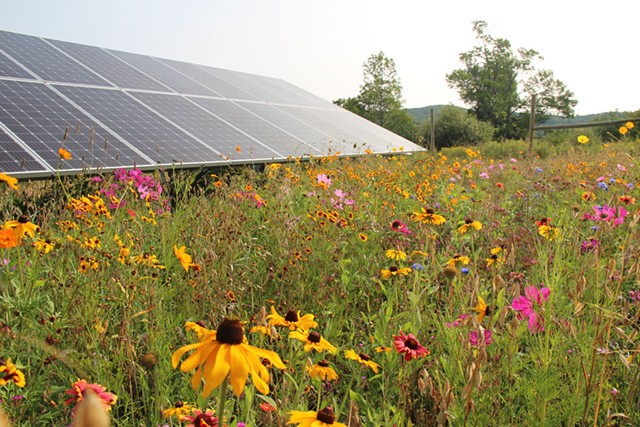
- Courtesy Of American Meadows
- A Bee the Change pollinator meadow at a solar installation
A perfectly manicured lawn has long been a symbol of status and leisure in America. And lawns do make nice places to sit. But they're also mowing headaches and water hogs that contribute to climate change and pollinator habitat loss. Lush lawns may rely on chemicals that pollute natural bodies of water and harm beneficial insects, including bees and butterflies. As people learn more about the cumulative negative impacts of lawns, many are reevaluating their place in our landscapes.
"Yes, You Can Do Better Than the Great American Lawn," a New York Times headline implored last spring.
Enter American Meadows' new tagline: "Meadowcaping Makes It Better."
Meadowscaping, for those unfamiliar with the term, "is a form of landscaping design that embraces natural growth," according to the website House Digest. "Meadowscaping reflects English countryside gardens and cottagecore aesthetics, with colorful wildflowers, tall grasses, and freeform garden beds ... Another step forward in the anti-lawn movement, meadowscaping aims to create low-maintenance gardens that are better for people, the planet, and pollinators."

- Courtesy Of American Meadows
- An urban meadowscape
As American Meadows' chief revenue officer, Brian Galloway, put it, "Consumers are more aware than ever before of what's going on with our climate, what's going on with Earth, what's going on with water. Your yard is in your control. It's one of those few things you can do.
"You can take out things that are eating up fossil fuels and taking chemicals to maintain, and you can replace them with feeding pollinators," Galloway continued. "That's you making a difference to transform not only your yard but your community and your world."
American Meadows unveiled its new vision-driven mission in February to help more people tap into sustainable yard solutions. It's not so much that the business has changed its practices — the company has championed meadowscaping for decades — as that the market finally caught up.
"We saw ourselves as a gardening company 10 years ago," president Ethan Platt said. "And now it's much bigger than that. I mean, a lot of our customers don't identify as gardeners. They're just, 'Hey, I've got a yard. I've got a balcony.'"
As commercial sales director Mike Lizotte, aka "the Seed Man," champions in his 2019 book, Mini Meadows: Grow a Little Patch of Colorful Flowers Anywhere Around Your Yard, you don't need acres to plant a meadow; you can "grow wildflowers in containers, along your walkway, to replace your lawn — truly anywhere."
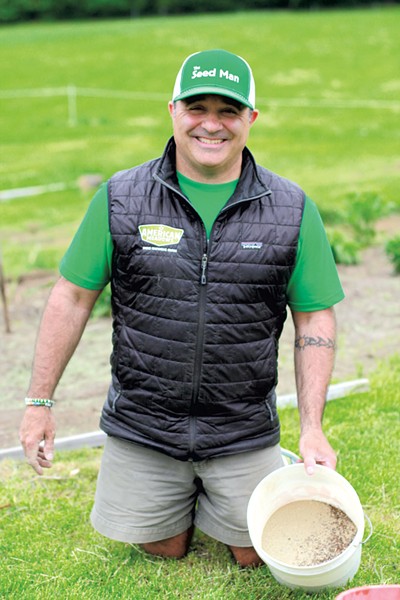
- Courtesy Of American Meadows
- Mike Lizotte, aka "the Seed Man," of American Meadows
A learning center on the company website welcomes users to the "Meadowverse" and provides resources, from growing guides to before-and-after success stories. Customers can shop "ready-made" meadows to fit their needs, whether they want to create a pollinator paradise (milkweed attracts monarch butterflies) or keep their homeowners' association happy (microclover creates a lush lawn but requires less water, fertilizer and mowing than traditional grass).
Over the years, American Meadows has built up credibility with customers. Its seeds are free of GMOs and neonicotinoids — an insecticide that has been linked to declining bee populations. And it doesn't use fillers to bulk up the product, which reduces shipping costs and carbon footprint. American Meadows also guarantees its products for a full year.
"Everything you see in here is lab-tested to make sure it hits certain germinations and purities that are the highest quality possible," said Lizotte, who began working at American Meadows as a teenager and became an owner in 2009.
The company's ethos and products have earned it a passionate customer base. One repeat client is Mike Kiernan, cofounder of Bee the Change, a Weybridge-based nonprofit that aims to create an acre of pollinator habitat in every Vermont city and town. American Meadows is his biggest seed supplier.
"We're very happy with their product," Kiernan said. "American Meadows is one of the companies that has ... planted an equal square footage of pollinator habitat to offset their warehouses."
Charlotte Addison is another regular customer. She moved to Charlotte four years ago, into a house on a steep hill that was difficult to mow. She needed plants that could keep the hillside from eroding but also wanted to explore making the space friendlier for wildlife and the climate. Wildflowers fit the bill.
"[American Meadows] really does cater to specific needs," Addison said. "If I have a hillside that's dry or I just need low-growing wildflowers ... it's really easy on their website to figure all those things out."
Addison documents her meadowscaping progress on her Instagram account, @addisonsvt. Come summer, her fields are a riot of daisies and colorful cosmos, zinnias and coneflowers.
"I will say, it gets very addictive," Addison said. "The hummingbirds in the summer here are just everywhere. It makes you want to do more and more. By doing so, you're creating this whole habitat in your backyard, and it's really, really cool."
Meadowscaping Tips From the Masters
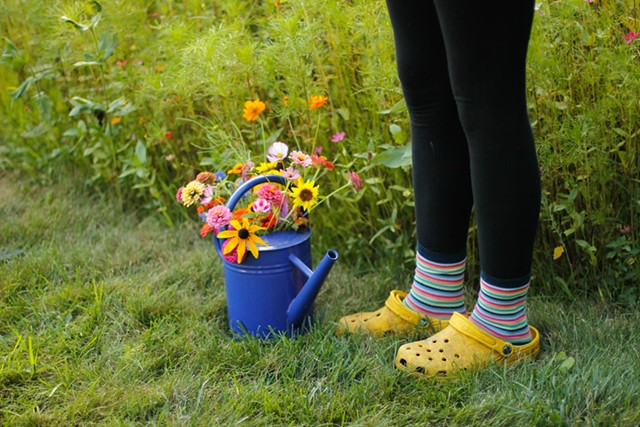
- Courtesy Of American Meadows
- A meadow bouquet
Wondering how to create a meadowscape in your yard, or even on your balcony? Read on for advice from American Meadows.
Get the lay of the land. Whether you're planning for an acre of wildflowers or a small container garden, you'll need to assess some basic details about your space. How much sun does it get? What's growing there now? One thing you probably won't need to worry much about is adding nutrients to the soil. "The beauty of wildflowers, and I think one of the reasons they're so attractive, is that they don't need to be pampered with good soil or fertilizer," American Meadows commercial sales director Mike Lizotte said.
Choose your mix. Looking for a blaze of colors ASAP? Or are you willing to wait an extra season for a longer-lasting bloom? Annual wildflowers will look great this year, while perennial flowers will grow more slowly but endure. You can always buy a mix for the best of both worlds. If you can afford it, try a native seed mix — these plants have evolved over millennia to provide added benefits to the local ecosystem.
Prepare your plot. "The more work you put into the preparation, the better results your planting is going to yield, both in the short and long term," Lizotte said. For a small plot, you might be able to get away with roughing up the surface with a steel rake. For bigger areas, you'll want to thoroughly till the soil, in multiple directions, to a depth of about six to eight inches. Alternatively or additionally, you can cover the area with heavy tarp for at least 90 days to kill all the grass and weeds.
Easy does it. Don't make the mistake of overseeding your wildflower garden. Each wildflower needs enough space to reach light, water and soil nutrients. "One of the reasons that some of our customers fail is they think, Oh, if a little seed is good, then a lot is better, and they end up planting too much," American Meadows president Ethan Platt said. "The plants then compete with each other and crowd each other out. It's a different mentality than planting grass seed."
Wait for warmer weather. Don't be fooled by that first 70-degree spring day. As any seasoned Vermont gardener knows, it's worth waiting until the last frost date to sow your seeds. That's usually between mid-May and Memorial Day weekend, depending on your region. However, if you've succumbed to temptation before a late frost, your seeds won't die — they'll just "lie dormant until the proper soil and air temperatures come together that promote germination," Lizotte said.
Don't forget to hydrate. It's important to have some moisture on the ground, especially those first few days after planting your seeds. If you have access to a water source, you can water the seeds every other day until they get established. But plenty of wildflower gardeners don't have a water source for their meadows. Instead, they plan their sowing around the weather forecast. "Take advantage of the spring rains that Mother Nature will give you, and then you may not have to end up watering your meadow at all," Lizotte said. "It doesn't take much."
Cut back once in late spring. Once wildflowers are established, they're pretty much set for the year. Maintenance generally includes cutting everything down with a Weedwacker or brush hog once a year — preferably after the last of the pollinators have left the ground. "I'll go down and cut my meadow in the spring after I've had a couple of weeks of above 50-degree weather, because by then anything that's nesting there will probably have moved out," Lizotte said.
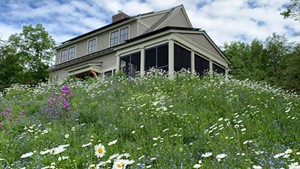









Comments
Comments are closed.
From 2014-2020, Seven Days allowed readers to comment on all stories posted on our website. While we've appreciated the suggestions and insights, right now Seven Days is prioritizing our core mission — producing high-quality, responsible local journalism — over moderating online debates between readers.
To criticize, correct or praise our reporting, please send us a letter to the editor or send us a tip. We’ll check it out and report the results.
Online comments may return when we have better tech tools for managing them. Thanks for reading.